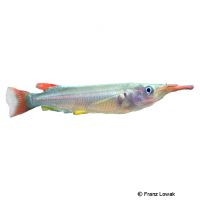Red-black Halfbeak (Nomorhamphus rex)
| Red-black Halfbeak Nomorhamphus rex | |
|---|---|
| Name | Red-black Halfbeak |
| Name Lat. | Nomorhamphus rex |
| Family | Viviparous Halfbeaks |
| Family lat. | Zenarchopteridae |
| Order | Needle Fishes |
| Order lat. | Beloniformes |
| Origin | Southeast Asia |
| Habitat | Forest streams |
| Diet | Carnivore |
| pH | 6.5-7.5 |
| Behavior | Peaceful |
| Keeping | Group |
| Care Level | Experts only |
| Reproduction | Livebearer |
| Breeding | Moderately difficult |
| Life Span | 2-3 years |
| Protection | No |
| Metric Units | |
| Size | 4-6 cm |
| Temperature | 24-28 °C |
| Hardness | 5-12 °dH |
| Aquarium | 80 l |
| US Units | |
| Size | 1.6"-2.4" |
| Temperature | 75-82 °F |
| Hardness | 89-214 ppm |
| Aquarium | 20 gal |
Distribution and habitat
The crepuscular red-black half-bill pike are found exclusively (endemically) in the interior of the island of Sulawesi (Indonesia). They live mainly in shady, fast-flowing forest streams with dense, weedy underwater vegetation, where they stay on the water surface to search for food.
Maintenance
The aquarium should have a varied, partly dense planting, with shelters and hiding places (roots) and provide sufficient swimming space. A dark substrate, shaded light (floating plants), soft to medium hard water and a strong current in places is ideal.
No ammonia, ammonium and nitrite should be detectable, the nitrate value should not exceed 100 mg/l. To ensure the water quality and the oxygen content, a filter adapted to the aquarium size and a heater are required, as well as lighting for the species-appropriate day-night rhythm of the animals.
Diet
They prefer to eat food from the water surface. The diet consists of small insects such as mosquitoes, aphids, fruit and fruit flies, plus cyclops, daphnia and mosquito larvae, which are also well accepted freeze-dried or frozen. After habituation, high-quality, protein-rich dry food (flakes, granules) is also accepted, but this should not be the main component of the diet.
Only as much should be fed as is eaten within a few minutes. A regular and varied diet promotes health and increases resistance
Behaviour and compatibility
They should be kept in a harem (1 male with 2 females) but better in a group of at least 10. They can be kept well in a community tank with other peaceful fish
Basically, only compatible fish species with similar demands on water condition and water temperature should be socialized.
Sex dimorphism
The males are smaller and have an anal fin (andropodium) that has been transformed into a mating organ. The larger females appear rounder.
Reproduction and breeding
They are viviparous fish. Internal fertilization is provided by the andropodium of the male. After 6-8 weeks of gestation, up to 10, approx. 2 cm large fry are born. They are already fully developed and independent at birth. The mother animal extremely preys on the young.
Young fish must be fed several times a day with special rearing food. In community tanks breeding is hardly possible, because the young fish are easy prey.
Important
The tank should be well covered, as they are good jumpers.
The well-being of the fish should be checked regularly. The temperature should be checked daily, the pH, hardness and nitrate value at least every 14 days. Regular partial water changes are recommended, even if the contaminant level has not yet reached the upper limit. Sudden changes in water quality should be avoided. Newly introduced fish must be accustomed slowly to the water in the aquarium.
Further literature can be found in your pet store.
References
Text: petdata; Image: Franz Lowak
Source: BMELV (1998): Tierschutzgutachten - Haltung von Zierfischen (Süßwasser); RIEHL & BAENSCH (2006): Aquarien Atlas Bd. 1, Mergus Verlag; ENGELMANN (2005): Zootierhaltung - Tiere in menschlicher Obhut: Fische, Verlag Harri Deutsch
- Gemäß § 21 Abs. 5 Tierschutzgesetz idgF
